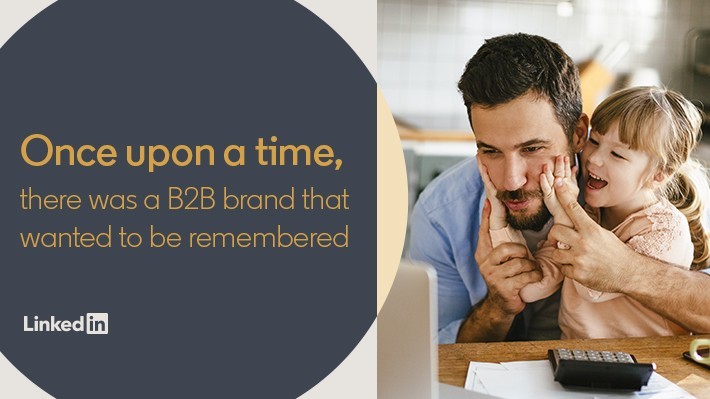Once upon a time, there was a B2B brand that wanted to be remembered
Think back to every advert you’ve seen for Disneyland. How many of them feature the rides? Can’t remember? Me neither. Now, what about that one with the children? You know, the journey from being told that they’re going to the moment they hug Mickey and Minnie? Their anticipation? The excitement? The joy?
Emotion is an intrinsic part of storytelling and multiple psychology studies have found that the stronger the emotion associated with a story, more likely you are to remember the details.
So when marketers add feeling to their brand story, it can have double the impact. Of course brands are looking for an emotive response from their audience, which is an essential part of brand building and long term growth. But it’s also true that the more engaging your story, the more likely it is that your audience will retain the information.
Traditional media has its limitations when it comes to storytelling. Print, tv, out-of-home: these formats mostly engage with a passive audience. In both the B2C and B2B worlds, audiences are eager for more interaction with brands.
That is why marketers are getting creative with telling their story digitally. It allows their audience to actively participate, which means far better engagement and consequently better overall campaign performance.
Demand is growing quickly from B2B audiences for interactive content experiences, but how do you start creating your own digital story? Here are three key building blocks to telling an emotive and compelling B2B tale.
The hook
The hook is what captures your prospects’ attention and makes them want to get involved. What problems does your target audience care about? What are they emotionally invested in as professionals? Success amongst their peers. Career advancement. Meaningful progress towards their personal and organisational objectives. These are all broadly true.
Your job is to find a way to distil those problems and desires into a single scenario that a) resonates within your target industries, b) plays to your strengths as both aesthetically as a brand and pragmatically as a company, and c) allows you to carve out some ownership of the topic compared to your competitors.
The narrative
Okay. Hook sorted. But who is your hero? How does your story start? What are they doing and why? Your narrative is defined by what you want your digital story to achieve. Are you telling the tale of your business, your product, your people or your customer? Whichever you choose, authenticity is more valuable than confected drama.
A good narrative is also much more than a beginning, middle and end (although those are very important too). It’s best to stick to a tried and tested formula, because it’s been proven to resonate with audiences already. A classic option is to begin with an inciting incident, which leads to action and grows to a climax, which is then resolved to the satisfaction of your audience.
Your choice of words is extremely important when it comes to tapping into that emotional response, so pay attention to the copywriting. Your story should also correspond to your brand voice, values and history, and don’t be put off if your brand or product doesn’t seem to fit naturally into a narrative.
This is something that Hewlett Packard Enterprise demonstrated extremely well with its “IT Monster” campaign. SaaS is not an easy story to tell, but HPE was able to create a lumbering, affable red hero that caused unwitting chaos around an office before being tamed by an HPE pro.
While aimed at IT professionals, the rare emotional tug of the narrative helped HPE’s campaign transcend the B2B tech audience. As a result, it achieved far wider popularity and continues to impact the brand’s presence in the enterprise IT market.
The medium
Now, this is where you can start being really innovative with your story and technology. The medium defines how your target audience experiences the narrative. There are a lot of options when it comes to digital, but you should still approach this with a cool head. It can be tempting to use more tools and be ever more expansive with the narrative scope. Resist that itch. Keep your story tight and focus on what you want to achieve with your audience.
Your perfect digital medium should be the centre of a Venn diagram with the tools that can tell your story on one side and your target audience’s favourite channels on the other. It doesn’t hurt to use a variety of content, as long as it’s well-executed, complementary and with a single objective in mind.
For a visual story, high quality images, videos and animations are essential, and an infographic can be a great way to simplify a difficult topic. Using different social media channels can allow you to tell a broader story by sequencing or overlapping perspectives on each channel. They also give you the chance to interact directly with your audience and (if you’re feeling brave) let them take control within the narrative.
Speaking of taking control, interactive video is the natural evolution of digital storytelling and is becoming more popular with both sides of the business / consumer market. It automatically makes the user the ‘hero’ of the story as part of a more immersive experience, while still giving brands complete command of which decisions participants can make. This can elicit an emotive response simply by offering users a chance to ‘win’ the experience. People remember pride in accomplishment – even if it’s just a game.
Find a way to make your audience feel
Whenever you ask someone why a particular story is their favourite, more often than not they will tell you how it made them feel. B2B brands can sometimes be guilty of shying away from this side of marketing. But non-fiction stories are often the most emotive and there has never been a greater variety of digital tools to help you tell a compelling B2B tale.
To explore the potential of B2B interactive content, visit LinkedIn Ad Vantage and immerse yourself in our ‘choose-your-own-adventure’ experience: A Day in the Life of a Marketer. The video below shows you what to expect. Don't forget to let us know what you think via #linkedinadvantage.
Related articles



